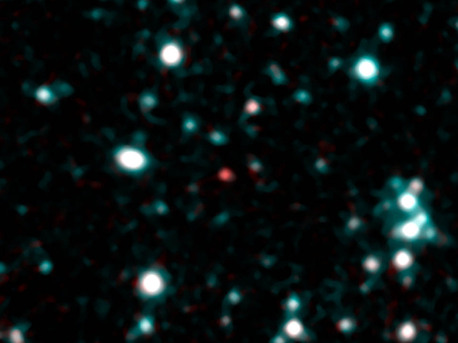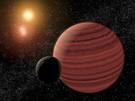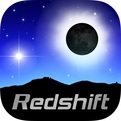Brown Dwarfs
The Coolest Stars Come Out of the Dark
 © NASA/JPL-Caltech/P. Eisenhardt (JPL)
|
This image shows what astronomers think is one of the coldest brown dwarfs discovered so far (red dot in middle of frame). The object, called SDWFS J143524.44+335334.6, is one of 14 such brown dwarfs found by NASA's Spitzer Space Telescope using infrared light. Follow-up observations are required to nail down this "failed" star's temperature, but rough estimates put this particular object at about 700 Kelvin (800 degrees Fahrenheit). In this image, infrared light with a wavelength of 3.6 microns is color-coded blue; 4.5-micron light is red. The brown dwarf shows up prominently in red because methane is absorbing the 3.6-micron, or blue-coded, light.
These cool orbs have remained elusive for years, but will soon start coming out of the dark in droves. NASA's Wide-field Infrared Survey Explorer (WISE) mission, which is up scanning the entire sky now in infrared wavelengths, is expected to find hundreds of objects of a similarly chilly disposition, if not even colder. WISE is searching a volume of space 40 times larger than that sampled in the recent Spitzer study, which concentrated on a region in the constellation Boötes. The Spitzer mission is designed to look at targeted patches of sky in detail, while WISE is combing the whole sky.
"WISE is looking everywhere, so the coolest brown dwarfs are going to pop up all around us," said Peter Eisenhardt, the WISE project scientist at NASA's Jet Propulsion Laboratory, Pasadena, Calif., and lead author of a recent paper in the Astronomical Journal on the Spitzer discoveries. "We might even find a cool brown dwarf that is closer to us than Proxima Centauri, the closest known star."
Brown dwarfs form like stars out of collapsing balls of gas and dust, but they are puny in comparison, never collecting enough mass to ignite nuclear fusion and shine with starlight. The smallest known brown dwarfs are about 5 to 10 times the mass of our planet Jupiter -- that's as massive as some known gas-giant planets around other stars. Brown dwarfs start out with a bit of internal heat left over from their formation, but with age, they cool down. The first confirmed brown dwarf was announced in 1995.
"Brown dwarfs are like planets in some ways, but they are in isolation," said astronomer Daniel Stern, co-author of the Spitzer paper at JPL. "This makes them exciting for astronomers -- they are the perfect laboratories to study bodies with planetary masses."
Most of the new brown dwarfs found by Spitzer are thought to belong to the coolest known class of brown dwarfs, called T dwarfs, which are defined as being less than about 1,500 Kelvin (2,240 degrees Fahrenheit). One of the objects appears to be so cold that it may even be a long-sought Y dwarf -- a proposed class of even colder stars. The T and Y classes are part of a larger system categorizing all stars; for example, the hottest, most massive stars are O stars; our sun is a G star.
"Models indicate there may be an entirely new class of stars out there, the Y dwarfs, that we haven't found yet," said co-author Davy Kirkpatrick, a co-author of the study and a member of the WISE science team at the California Institute of Technology, Pasadena, Calif. "If these elusive objects do exist, WISE will find them." Kirkpatrick is a world expert in brown dwarfs -- he came up with L, T and Y classifications for the cooler stars.
Kirkpatrick says that it's possible that WISE could find an icy, Neptune-sized or bigger object in the far reaches of our solar system -- thousands of times farther from the sun than Earth. There is some speculation amongst scientists that such a cool body, if it exists, could be a brown dwarf companion to our sun. This hypothetical object has been nicknamed "Nemesis."
"We are now calling the hypothetical brown dwarf Tyche instead, after the benevolent counterpart to Nemesis," said Kirkpatrick. "Although there is only limited evidence to suggest a large body in a wide, stable orbit around the sun, WISE should be able to find it, or rule it out altogether."
The 14 objects found by Spitzer are hundreds of light-years away -- too far away and faint for ground-based telescopes to see and confirm with a method called spectroscopy. But their presence implies that there are a hundred or more within only 25 light-years of our sun. Because WISE is looking everywhere, it will find these missing orbs, which will be close enough to confirm with spectroscopy. It's possible that WISE will even find more brown dwarfs within 25-light years of the sun than the number of stars known to exist in this space.
"WISE is going to transform our view of the solar neighborhood," said Eisenhardt. We'll be studying these new neighbors in minute detail -- they may contain the nearest planetary system to our own."
Source: NASA
Brown Dwarfs
The Coolest Stars Come Out of the Dark
 © NASA/JPL-Caltech/P. Eisenhardt (JPL)
|
This image shows what astronomers think is one of the coldest brown dwarfs discovered so far (red dot in middle of frame). The object, called SDWFS J143524.44+335334.6, is one of 14 such brown dwarfs found by NASA's Spitzer Space Telescope using infrared light. Follow-up observations are required to nail down this "failed" star's temperature, but rough estimates put this particular object at about 700 Kelvin (800 degrees Fahrenheit). In this image, infrared light with a wavelength of 3.6 microns is color-coded blue; 4.5-micron light is red. The brown dwarf shows up prominently in red because methane is absorbing the 3.6-micron, or blue-coded, light.
These cool orbs have remained elusive for years, but will soon start coming out of the dark in droves. NASA's Wide-field Infrared Survey Explorer (WISE) mission, which is up scanning the entire sky now in infrared wavelengths, is expected to find hundreds of objects of a similarly chilly disposition, if not even colder. WISE is searching a volume of space 40 times larger than that sampled in the recent Spitzer study, which concentrated on a region in the constellation Boötes. The Spitzer mission is designed to look at targeted patches of sky in detail, while WISE is combing the whole sky.
"WISE is looking everywhere, so the coolest brown dwarfs are going to pop up all around us," said Peter Eisenhardt, the WISE project scientist at NASA's Jet Propulsion Laboratory, Pasadena, Calif., and lead author of a recent paper in the Astronomical Journal on the Spitzer discoveries. "We might even find a cool brown dwarf that is closer to us than Proxima Centauri, the closest known star."
Brown dwarfs form like stars out of collapsing balls of gas and dust, but they are puny in comparison, never collecting enough mass to ignite nuclear fusion and shine with starlight. The smallest known brown dwarfs are about 5 to 10 times the mass of our planet Jupiter -- that's as massive as some known gas-giant planets around other stars. Brown dwarfs start out with a bit of internal heat left over from their formation, but with age, they cool down. The first confirmed brown dwarf was announced in 1995.
"Brown dwarfs are like planets in some ways, but they are in isolation," said astronomer Daniel Stern, co-author of the Spitzer paper at JPL. "This makes them exciting for astronomers -- they are the perfect laboratories to study bodies with planetary masses."
Most of the new brown dwarfs found by Spitzer are thought to belong to the coolest known class of brown dwarfs, called T dwarfs, which are defined as being less than about 1,500 Kelvin (2,240 degrees Fahrenheit). One of the objects appears to be so cold that it may even be a long-sought Y dwarf -- a proposed class of even colder stars. The T and Y classes are part of a larger system categorizing all stars; for example, the hottest, most massive stars are O stars; our sun is a G star.
"Models indicate there may be an entirely new class of stars out there, the Y dwarfs, that we haven't found yet," said co-author Davy Kirkpatrick, a co-author of the study and a member of the WISE science team at the California Institute of Technology, Pasadena, Calif. "If these elusive objects do exist, WISE will find them." Kirkpatrick is a world expert in brown dwarfs -- he came up with L, T and Y classifications for the cooler stars.
Kirkpatrick says that it's possible that WISE could find an icy, Neptune-sized or bigger object in the far reaches of our solar system -- thousands of times farther from the sun than Earth. There is some speculation amongst scientists that such a cool body, if it exists, could be a brown dwarf companion to our sun. This hypothetical object has been nicknamed "Nemesis."
"We are now calling the hypothetical brown dwarf Tyche instead, after the benevolent counterpart to Nemesis," said Kirkpatrick. "Although there is only limited evidence to suggest a large body in a wide, stable orbit around the sun, WISE should be able to find it, or rule it out altogether."
The 14 objects found by Spitzer are hundreds of light-years away -- too far away and faint for ground-based telescopes to see and confirm with a method called spectroscopy. But their presence implies that there are a hundred or more within only 25 light-years of our sun. Because WISE is looking everywhere, it will find these missing orbs, which will be close enough to confirm with spectroscopy. It's possible that WISE will even find more brown dwarfs within 25-light years of the sun than the number of stars known to exist in this space.
"WISE is going to transform our view of the solar neighborhood," said Eisenhardt. We'll be studying these new neighbors in minute detail -- they may contain the nearest planetary system to our own."
Source: NASA







